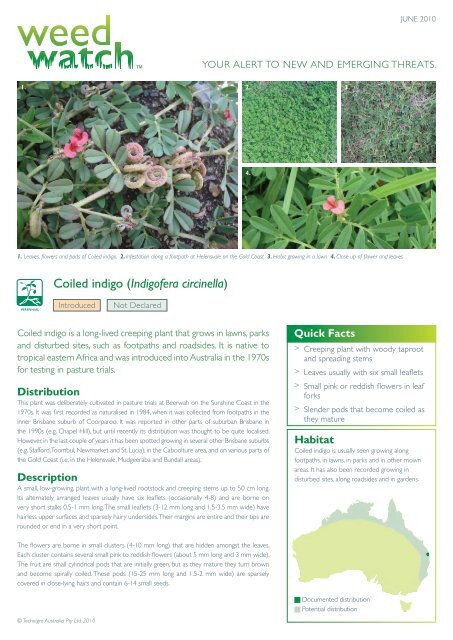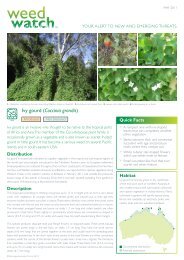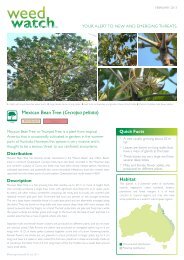Coiled indigo (Indigofera circinella) - Technigro
Coiled indigo (Indigofera circinella) - Technigro
Coiled indigo (Indigofera circinella) - Technigro
Create successful ePaper yourself
Turn your PDF publications into a flip-book with our unique Google optimized e-Paper software.
1. 2.<br />
1. Leaves, flowers and pods of <strong>Coiled</strong> <strong>indigo</strong>. 2. Infestation along a footpath at Helensvale on the Gold Coast 3. Habit growing in a lawn 4. Close up of flower and leaves<br />
<strong>Coiled</strong> <strong>indigo</strong> (<strong>Indigofera</strong> <strong>circinella</strong>)<br />
<strong>Coiled</strong> <strong>indigo</strong> is a long-lived creeping plant that grows in lawns, parks<br />
and disturbed sites, such as footpaths and roadsides. It is native to<br />
tropical eastern Africa and was introduced into Australia in the 1970s<br />
for testing in pasture trials.<br />
Distribution<br />
This plant was deliberately cultivated in pasture trials at Beerwah on the Sunshine Coast in the<br />
1970s. It was first recorded as naturalised in 1984, when it was collected from footpaths in the<br />
inner Brisbane suburb of Coorparoo. It was reported in other parts of suburban Brisbane in<br />
the 1990s (e.g. Chapel Hill), but until recently its distribution was thought to be quite localised.<br />
However, in the last couple of years it has been spotted growing in several other Brisbane suburbs<br />
(e.g. Stafford, Toombul, Newmarket and St. Lucia), in the Caboolture area, and on various parts of<br />
the Gold Coast (i.e. in the Helensvale, Mudgeeraba and Bundall areas).<br />
Description<br />
A small, low-growing, plant with a long-lived rootstock and creeping stems up to 50 cm long.<br />
Its alternately arranged leaves usually have six leaflets (occasionally 4-8) and are borne on<br />
very short stalks 0.5-1 mm long. The small leaflets (3-12 mm long and 1.5-3.5 mm wide) have<br />
hairless upper surfaces and sparsely hairy undersides. Their margins are entire and their tips are<br />
rounded or end in a very short point.<br />
The flowers are borne in small clusters (4-10 mm long) that are hidden amongst the leaves.<br />
Each cluster contains several small pink to reddish flowers (about 5 mm long and 3 mm wide).<br />
The fruit are small cylindrical pods that are initially green, but as they mature they turn brown<br />
and become spirally coiled. These pods (15-25 mm long and 1.5-2 mm wide) are sparsely<br />
covered in close-lying hairs and contain 6-14 small seeds.<br />
© <strong>Technigro</strong> Australia Pty Ltd 2010<br />
TM<br />
Introduced Not Declared<br />
JUNE 2010<br />
YOUR ALERT TO NEW AND EMERGING THREATS.<br />
4.<br />
3.<br />
Quick Facts<br />
> Creeping plant with woody taproot<br />
and spreading stems<br />
> Leaves usually with six small leaflets<br />
> Small pink or reddish flowers in leaf<br />
forks<br />
> Slender pods that become coiled as<br />
they mature<br />
Habitat<br />
<strong>Coiled</strong> <strong>indigo</strong> is usually seen growing along<br />
footpaths, in lawns, in parks and in other mown<br />
areas. It has also been recorded growing in<br />
disturbed sites, along roadsides and in gardens.<br />
Documented distribution<br />
Potential distribution
1. 2.<br />
1. Growing on a creekbank in Toombul. 2. Close up of coiled pods.<br />
Your Provider of Vegetation Management Solutions<br />
Brisbane: 3, 128 South Pine Road, Brendale, QLD. 4550<br />
Gold Coast: 2-10 Rudman Parade, Andrews, QLD. 4220<br />
Post: PO Box 2038, Burleigh BC, QLD, 4220<br />
TM<br />
Reproduction and Dispersal<br />
This species only reproduces by seed. Because it often grows in lawns and other mown<br />
areas, it is most probably dispersed as a result of mowing activities (i.e. in clippings or on<br />
contaminated equipment).<br />
Why is it an Emerging Threat?<br />
<strong>Coiled</strong> <strong>indigo</strong> has the potential to become a troublesome weed of lawns and other mown<br />
areas – in the same way that Creeping <strong>indigo</strong> already has. Based on its native distribution<br />
in Africa, it is likely to continue to spread and become established throughout the tropical<br />
and sub-tropical parts of northern and eastern Australia.<br />
Control Methods<br />
Individual specimens can be removed manually, although it is often advisable to loosen the soil<br />
around the main taproot prior to applying any force. When operating mowing equipment,<br />
clean or blow down prior to leaving the infested area. If clippings are being collected, these<br />
should be bagged or contained and then disposed of in a sanitary manner.<br />
While no chemicals are currently registered for the control of <strong>Coiled</strong> <strong>indigo</strong>, documentation<br />
shows that other species belonging to this genus are known to be susceptible to<br />
formulations containing a mixture of Dicamba and MCPA. This information can be viewed<br />
at www.tropicalforages.info/key/Forages/Media/Html/<strong>Indigofera</strong>_spicata.htm. Improved<br />
results from chemical control are likely to be obtained if treatment occurs prior to plants<br />
reaching a mature size.<br />
Within Queensland, the use of Dicamba and MCPA formulations is permitted for the spot<br />
spraying of environmental weeds such as <strong>Coiled</strong> <strong>indigo</strong> in non-crop situations via off-label<br />
permit 11463 (http://permits.apvma.gov.au/PER11463.PDF). Before applying this method<br />
of control within other state boundaries, it is recommended that all operators consult any<br />
relevant permits or government legislation.<br />
T: 1800 678 611 www.technigro.com.au<br />
Look a-likes<br />
<strong>Coiled</strong> <strong>indigo</strong> is very similar to Creeping <strong>indigo</strong><br />
(<strong>Indigofera</strong> spicata), another much more common<br />
and widespread weed of mown areas in eastern<br />
Australia. However, the pods of Creeping <strong>indigo</strong> are<br />
straight and its pink to orange flowers are borne in<br />
much larger clusters (3-8 cm long).<br />
Top. Straight pods.<br />
Bottom. Larger clusters with numerous flowers.<br />
JUNE 2010<br />
YOUR ALERT TO NEW AND EMERGING THREATS.<br />
The control methods referred to in Weed Watch should be used in accordance with the restrictions (federal and state legislation and local government laws) directly or indirectly related<br />
to each control method. These restrictions may prevent the utilisation of one or more of the methods referred to, depending on individual circumstances. While every care is taken to ensure<br />
the accuracy of this information, <strong>Technigro</strong> does not invite reliance upon it, nor accept responsibility for any loss or damage caused by actions based on it.<br />
This information has been developed with the assistance of Dr Sheldon Navie. Photographs are also courtesy of Dr Navie. © <strong>Technigro</strong> Australia Pty Ltd 2010<br />
for smarter solutions





